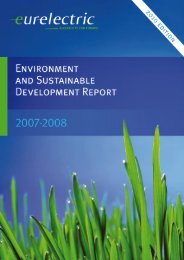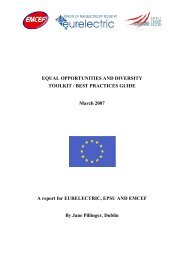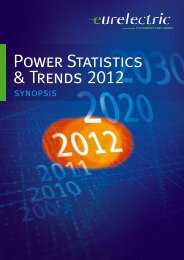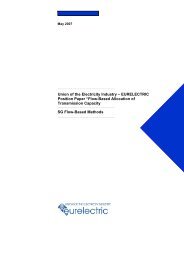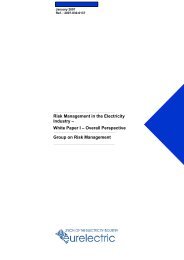Hydro in Europe: Powering Renewables - Full Report - Eurelectric
Hydro in Europe: Powering Renewables - Full Report - Eurelectric
Hydro in Europe: Powering Renewables - Full Report - Eurelectric
Create successful ePaper yourself
Turn your PDF publications into a flip-book with our unique Google optimized e-Paper software.
5. <strong>Hydro</strong>power is the only large-scale and cost-efficient storage technology<br />
available today<br />
Despite promis<strong>in</strong>g developments <strong>in</strong> energy storage technologies, hydropower with<br />
reservoirs is still the only technology offer<strong>in</strong>g economically viable large-scale<br />
storage. It is also a very efficient and competitive energy storage option. Pumped<br />
storage power plants are five times less expensive than batteries and four times<br />
less costly than compressed air energy storage technologies. Conventional storage<br />
hydro projects are even less expensive than pumped storage plants.<br />
6. <strong>Hydro</strong>power reduces <strong>Europe</strong>’s import dependency<br />
<strong>Europe</strong> is highly dependent on fossil fuel imports. <strong>Hydro</strong>power is part of <strong>Europe</strong>’s<br />
domestic resources and should be fully developed <strong>in</strong> order to diversify the<br />
electricity mix and enhance security of supply.<br />
7. <strong>Hydro</strong>power is the most efficient power generation technology<br />
<strong>Hydro</strong>power has both a high energy payback ratio and a high conversion<br />
efficiency, mak<strong>in</strong>g it very resource-effective. It has the highest efficiency rate<br />
among all electricity generat<strong>in</strong>g technologies, and offers the highest levels of<br />
services. Operation efficiency rates for conventional hydropower plants range<br />
from 85-95% (70-75% for pumped storage power plants). This is significantly<br />
higher than the 55% for comb<strong>in</strong>ed-cycle gas turb<strong>in</strong>es, the 30-40% for coal or oil<br />
fired plants, the 30% for w<strong>in</strong>d power and the 7-17% for solar photovoltaic panels.<br />
8. The potential of hydropower’s technologies should benefit to the <strong>Europe</strong>an<br />
system as a whole<br />
<strong>Hydro</strong>power storage technologies are currently designed for a national or regional<br />
scale, with limited consideration for a <strong>Europe</strong>an system. S<strong>in</strong>ce hydropower and<br />
pumped storage are scarce and highly valuable resources, their potential has to be<br />
used to its optimum on a <strong>Europe</strong>an or even pan-<strong>Europe</strong>an scale. Improved grids<br />
and <strong>in</strong>terconnections are of prime importance to tap <strong>in</strong>to this significant unused<br />
potential of renewable energy generation.<br />
9. <strong>Hydro</strong>power plays an important role <strong>in</strong> water management<br />
<strong>Hydro</strong>power has a long history <strong>in</strong> act<strong>in</strong>g <strong>in</strong> water management to plan energy<br />
generation but also <strong>in</strong> cooperation with other needs such as freshwater handl<strong>in</strong>g,<br />
boat traffic and flood control.<br />
EURELECTRIC acknowledges the important achievements of environmental<br />
legislation, from Natura 2000 to the WFD. To nevertheless ensure a susta<strong>in</strong>able<br />
perspective on water use management, the WFD should be applied based on a<br />
thorough socio-economic cost-benefit analysis that covers the full range of water<br />
services provided by hydropower. S<strong>in</strong>ce hydropower is a site-specific technology,<br />
arbitration should take place on a case-by-case basis.<br />
59



